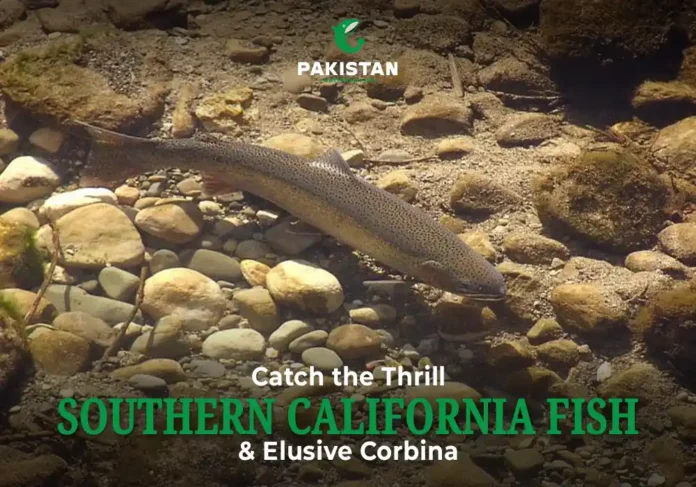Southern California fish are the manner of speaking; they’re part of the lifestyle here. At the shoreline families are busy in fishing, kids happy and playing in the waves, and travelers watching silver flashes.
From bays to beaches, the waters are spirited with variety that makes every journey episodic.
And in all that, every fish has its own personality and place in the hearts of Social anglers — the California Corbina.
What Makes the California Corbina So Special?
Picture this: the sun’s just come up, waves are rolling gently, and you’re standing knee-deep in the surf. Out of the corner of your eye, you catch a shadow slipping along the sand like a ghost. That’s a California corbina. Sleek, silver, and fast.
Unlike their noisy croaker cousins, corbina don’t croak. They don’t even have the swim bladder that makes the sound. Instead, they move in silence, darting and weaving with stealth. That’s part of the thrill — they’re unpredictable.
They’re not giants, averaging one to two feet, but the fight they put up is something else. When a corbina hits, it runs with the determination of a fish three times its size. It’s no wonder surf anglers call it the “ghost of the beach.”
There’s another reason they matter. If corbina are feeding close to shore, it usually means the water’s clean and the ecosystem is balanced. Think of them as the canaries of the coastline.
The Variety Keeps It Exciting
At first glance, corbina all look alike — silver backs, white bellies. But if you fish different beaches, you’ll notice the variety. In San Diego’s bays, you’ll often land smaller corbina under a foot long, perfect for kids learning to fish. Head north toward Ventura, and suddenly you’re fighting a 28-inch beauty flashing like treasure in the waves.
Their habits shift too. Some travel in loose schools, rooting through the sand for crabs. Others roam solo, cruising the shallows like lone wolves. This mix keeps things exciting. You never know if your next bite is from a youngster or a big veteran fighter.
One trick: watch the sand. When you see little boils or swirls, that’s corbina digging for food. Cast there. It feels almost like reading ocean secrets — and it works.
Other Southern California Fish You’ll Love Catching
Corbina may be the highlight, but Southern California fishing isn’t short on variety. Here are some favorites:
- Rockfish (Sebastes) – Colorful, tasty, and often found around kelp forests. Hook one on light tackle, and it’s a solid fight.
- Calico Bass (Paralabrax clathratus) – Aggressive and scrappy. These reef dwellers strike hard and test your patience.
- Yellowtail (Seriola lalandi) – The heavy hitters offshore. Hooking one feels like you’ve strapped onto a freight train.
- California Halibut (Paralichthys californicus) – Masters of camouflage, waiting on sandy bottoms to ambush prey. When they strike, they strike hard.
- Surfperch (Family Embiotocidae) – Beginner-friendly, always around, and great for kids to catch year-round.
- Croakers (Family Sciaenidae) – Spotfin and yellowfin croakers are common cousins of corbina, each with their quirks.
That’s the beauty of these waters. One trip can deliver a mixed bag — a rockfish, a perch, maybe even a halibut. Fish where sand meets rock, and your odds of variety shoot way up.
Corbina vs Croaker — Clearing Up the Confusion
Anglers new to SoCal often mix up corbina with croakers. They’re in the same family, but they’re not the same.
- Body: Corbina are longer and sleeker. Croakers are chunkier and have a chin barbel.
- Sound: Croakers croak (hence the name). Corbina are silent.
- Habitat: Croakers hang around bays; corbina love sandy beaches.
- Fight: Croakers pull steady; corbina give quick bursts of speed.
- Taste: Corbina are mild and flaky, while croakers have a gamier edge.
If you want to sharpen your skills, target corbina. They’re trickier, faster, and more rewarding.
Tips for Catching Corbina Like a Local
Corbina fishing isn’t about luck. It’s about patience, timing, and the right setup.
- Rig: Carolina rig is your friend sliding sinker, bead, swivel, and a two-foot leader with a #4 Kahle hook. It lets your bait move naturally in the surf.
- Rod & Line: A 7–9 foot surf rod with 10–15 lb test line hits the sweet spot.
- Bait: Sand crabs are unbeatable. Ghost shrimp and bloodworms also tempt corbina, but crabs are the real deal.
- Where to Cast: Target troughs between waves. That’s where corbina cruise for food.
- When to Fish: Early mornings and evenings during a rising tide. Low tide sight-fishing is gold, spot those tails flicking above the water and cast nearby.
It’s a waiting game. Unlike tossing a lure into a lake and hoping, surf fishing for corbina feels like a dance between angler and ocean. You watch, you read the signs, and when the strike comes then you’ll never forget it.
FAQs About Corbina
Final Cast
Fishing in Southern California isn’t just about filling coolers with fish. It’s about mornings spent with your kids digging for sand crabs, the thrill of spotting a silver flash in the surf, and the stories that come from each tug on the line.
Among all southern California fish, corbina stand out as the ultimate surf challenge. They’re fast, finicky, and unforgettable. Catching one feels like winning a small battle with the ocean itself.
So next time you’re standing barefoot in the sand, rod in hand, keep your eyes on the shallows. A corbina might just be cruising by, waiting to give you the kind of memory that lasts long after the tide goes out.


